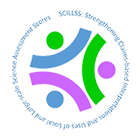NGSS Resources |
| The Standards A Framework for K-12 Science Education Developing Assessments for the NGSS Guide to Implementing the NGSS NGSS Resource Library |
The SCILLSS project places an emphasis on academic content standards in science because by 2017, many states have had an opportunity to work through assessment design with an assessment consortia or on their own for both ELA and mathematics, but have not done so for science. SCILLSS focuses on the Next Generation Science Standards (NGSS) because with 17 states having adopted this set of common science standards, there is cross-state applicability and generalizability beyond the states engaged in this project.
The NGSS are research-based, K-12 science content standards developed by states to improve science education for all students. The standards incorporate three important dimensions (crosscutting concepts, disciplinary core ideas, and science and engineering practices). These dimensions are combined to form each standard and are intended to promote classroom learning experiences that help students stimulate interest in and develop a cohesive understanding of science over time.
- Crosscutting concepts encourage students to make connections between four science and engineering domains (Physical Science, Life Science, Earth and Space Science, and Engineering Design) and develop a scientifically-based worldview. These concepts are applicable across all four domains and include, for example, cause and effect, proportion and quantity, and energy and matter.
- Disciplinary core ideas are the key ideas that have widespread significance and impact on the four science and engineering domains. These core ideas anchor K-12 curriculum, instruction, and assessment in the foundational elements of science and engineering.
- Science and engineering practices allow students to apply their knowledge of crosscutting concepts and disciplinary core ideas though inquiry, investigation, design, and development. The practical application of these practices helps students understand the relevance and importance of STEM to real-world challenges.
These new, three-dimensional standards pose unique challenges to assessment and demand new ways of measuring science learning to ensure students are being assessed on complex science thinking, not just superficial knowledge. SCILLSS will produce tools and resources aligned to NGSS, affording states the option to apply the principled-design framework and processes to their state-specific academic standards or, if they are a NGSS state, to adopt the materials that are developed in alignment. Through the use of detailed guidance and tools, key facets of the state-specific work completed through this project will be adaptable to other states’ contexts and sustainable beyond the life of the project.
